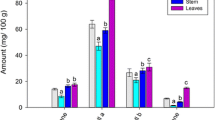Abstract
Caffeic acid, rosmarinic acid, rutin, apigenin 7-O-glucoside, apigenin, and acesetin were the main phenolic compounds of Origanum onites extracts in all applications. While acesetin contents ranged from 133.59 mg/100 g (U1) to 437.25 mg/100 g (S3), rosmarinic acid changed between 215.94 mg/100 g (U4) and 1120.56 mg/100 g (S2) in Origanum vulgare L. subsp. hirtum (Link) Ietsw. Both rosmarinic acid and acesetin were not found in U5 application. Only caffeic acid (19.39 mg/100 g) was found in U5 application. Rosmarinic acid contents of O. onites extract changed between 158.62 mg/100 g (U5) and 799.87 mg/100 g (S2). Generally, dominant phenolic compound of Origanum extracts was rosmarinic acid compared with other extracts. In addition, methanol:water:acetic acid mixture (S2) (95:4.5:0.5) was found as the best application. Phenolic contents of extracts obtained with U series mixtures were found low.

Similar content being viewed by others
References
Baytop,T. (1984). Treatment with plants in Turkey. İstanbul Univ Publ Nu 3255, İstanbul ,Turkey, (in Turkish).
Chun, S. S., Vattem, D. A., Lin, Y. T., & Shetty, K. (2005). Phenolic antioxidants from clonal oregano (Origanum vulgare) with antimicrobial activity against Helicobacter pylori. Process Biochemistry, 40, 809–816.
Grevsen, K., Fretté, X. C., & Christensen, L. P. (2009). Content and composition of volatile terpenes, flavonoids and phenolic acids in Greek oregano (Origanum vulgare L. ssp. hirtum) at different development stages during cultivation in cool temperate climate. European Journal of Horticulture Science, 74(5), 193–203.
Ivanauskas, L., Jakštas, V., Radušienė, J., Lukošius, A., & Aranauskas, A. (2008). Evaluation of phenolic acids and phenylpropanoids in the crude drugs. Medicina (Kaunas, Lithuania), 44(1), 48–55.
Kikuzaki, H., & Nakatani, N. (1989). Structure of a new antioxidative phenolic acid from oregano (Origanum vulgare L.). Agriculture, Biology Chemistry, 53, 519–524.
Kirthikar, K.R., Basu, B.D., (1994). Allahabad: Bishan Singh Mahendra Pal Singh; 1994. Indian medicinal plants; Vol. 3., p. 1986.
Koşar, M., Dorman, H. J. D., Bachmayer, O., Başer, K. H. C., & Hiltunen, R. (2003). An improved on-line HPLC-DPPH method for the screening of free radical scavenging compounds in water extracts of Lamiaceae plants. Chemistry of Natural Compounds, 39(2), 161–166.
Koşar, M., Dorman, H. J. D., & Hiltunen, R. (2005). Effect of an acid treatment on the phytochemical and antioxidant characteristics of extracts from selected Lamiaceae species. Food Chemistry, 91, 525–533.
Koukoulitsa, C., Karioti, A., Bergonzi, C., Pescitelli, G., Bari, L. D., & Skaltsa, H. (2006). Polar constituents from the aerial parts of Origanum vulgare L. ssp. hirtum growing wild in Greece. Journal of Agriculture and Food Chemistry, 54, 5388–5392.
Özdamar, K., (1999). SPPS ile Bioistatistik ETAM A.Ş. Matbaa Tesisleri. Yayin No: 3. 454 s., Eskişehir.
Pizzale, L., Bortolomeazzi, R., Vichi, S., Uberegger, E., & Lanfranco, S. C. (2002). Antioxidant activity of sage (Salvia officinalis and S. fruticosa) and oregano (Origanum onites and O. indercedens) extracts related to their phenolic compound content. Journal of the Science of Food and Agriculture, 82, 1645–1651.
Singleton, V. L., & Rossi, J. R. (1965). Colorimetry of total phenolics with phosphomolibdic-phosphotungstic acid. American Journal of Enology and Viticulture, 16, 144–158.
Skerget, M., Kotnik, P., Hadolin, M., Rizner Hras, A., Simonic, M., & Knez, Z. (2005). Phenols, proanthocyanidins, flavones and antioxidant activities. Food Chemistry, 89, 191–198.
Wojdyło, A., Oszmian’sk, J., & Czemerys, R. (2007). Antioxidant activity and phenolic compounds in 32 selected herbs. Food Chemistry, 105, 940–949.
Vijaya, M., Cass, I., Judy, G., Talpur, M. A., Echard, B. W., & Bagchi, D. (2001). Antifungal activities of origanum oil against Candida albicans. Molecular and Cellular Biochemistry, 228, 111–117.
Zheng, W., & Weng, S. Y. (2001). Antioxidant activity and phenolic compounds in selected herbs. Journal of Agricultural and Food Chemistry, 49, 5165–5170.
Acknowledgments
This work was supported by The Scientific and Technological Research Council of Turkey (TÜBİTAK-TOGTAG).
Author information
Authors and Affiliations
Corresponding author
Rights and permissions
About this article
Cite this article
Özkan, G., Özcan, M.M. Some phenolic compounds of extracts obtained from Origanum species growing in Turkey. Environ Monit Assess 186, 4947–4957 (2014). https://doi.org/10.1007/s10661-014-3750-5
Received:
Accepted:
Published:
Issue Date:
DOI: https://doi.org/10.1007/s10661-014-3750-5



